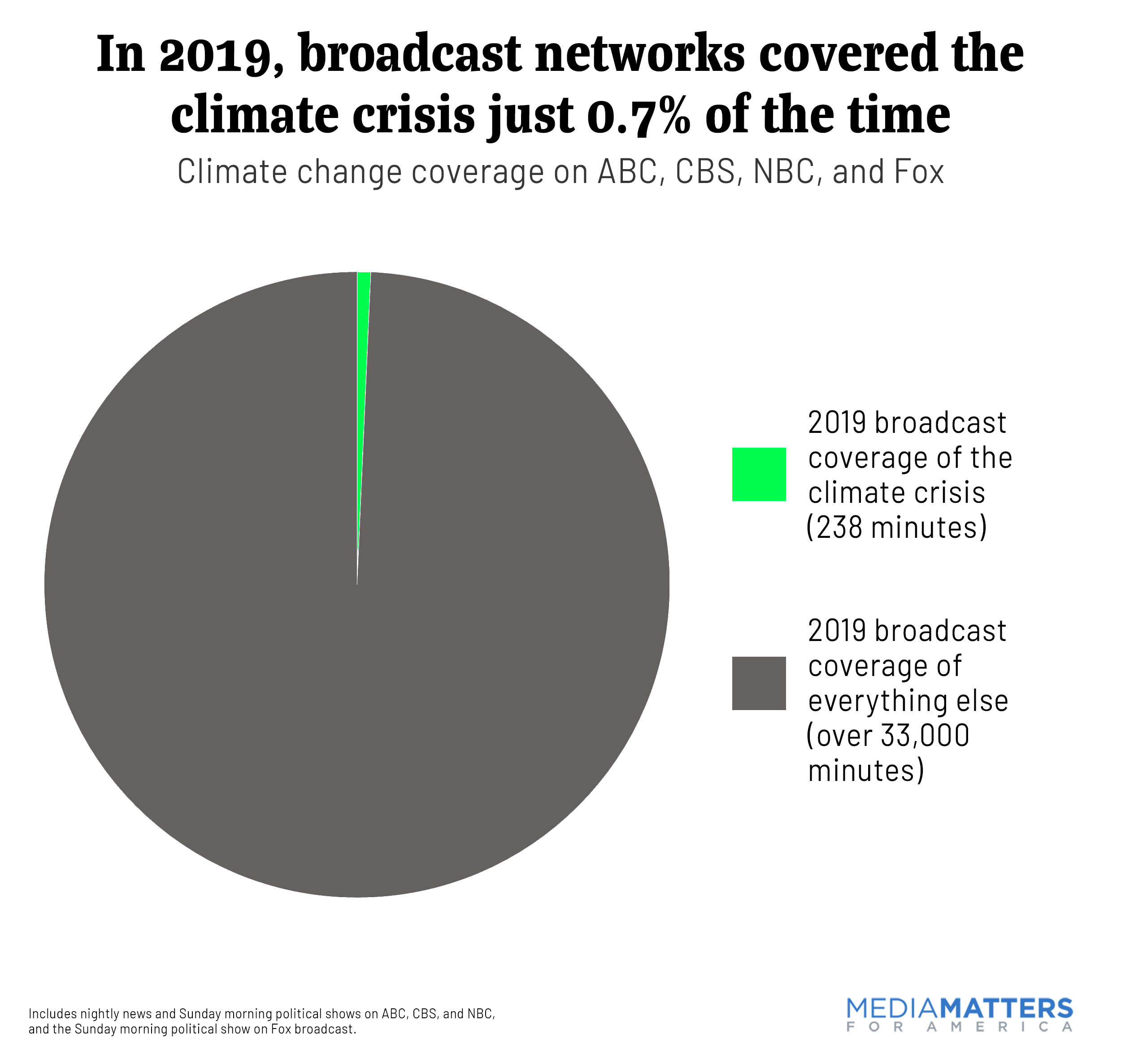When it comes to climate change, television news is covering little more than the tip of the iceberg.
That’s according to a just-released report from Media Matters for America, which found that global warming garnered a tiny sliver — well under 1 percent — of overall broadcast news coverage. The progressive research nonprofit also found that, while these news outlets did cover climate change more often in 2019 than in the year prior, the quality of coverage was “generally shallow.” And when it came to giving voice to those hit first and worst by extreme weather and other climate-related disasters, the networks fell short: People of color were “massively underrepresented” in coverage.
“In spite of the increase in coverage from 2018 to 2019, climate coverage as a whole still made up only 0.6% of overall corporate broadcast TV nightly news in 2019, showing that these programs’ climate coverage does not adequately reflect the urgency and severity of the climate crisis,” the report found.
The study analyzed four nightly news programs and four Sunday morning political shows, focusing both on segments devoted to climate change as well as substantial mentions of the topic in other segments. Yet even with significant year-to-year increases in coverage — for example, a 180 percent increase in climate coverage on nightly news in 2019 compared to 2018 — corporate broadcasters failed to substantially improve the overall quantity and quality of their climate coverage, according to Media Matters.
The analysis focused on four nightly news programs — ABC’s World News Tonight, CBS Evening News, NBC’s Nightly News, and public broadcaster PBS’s NewsHour — as well as four Sunday morning political shows: ABC’s This Week With George Stephanopoulos, CBS’s Face the Nation, NBC’s Meet the Press, and Fox Broadcasting Co.’s Fox News Sunday. Media Matters has produced variations of this analysis annually since at least 2012, including reports in 2018 and 2017.
Among the report’s key findings for 2019:
- Although the volume of climate change coverage on the corporate broadcast nightly and Sunday morning news shows increased 68 percent from 2018 to 2019 (142 minutes to 238 minutes), the report noted that this was not difficult to achieve because the amount of coverage in 2018 was “so pitiful” that news shows had a low bar to meet the following year. This climate coverage represented just .07 percent of the overall broadcast nightly and Sunday morning news shows in 2019.

- When it came to racial and gender diversity in their climate coverage, Media Matters found that broadcast television also failed: People of color were “massively underrepresented” as news guests, even though communities of color are disproportionately impacted by climate change. Just 10 percent of guests interviewed or featured in these news segments were people of color, and 2019 was the third year in a row that representation came in at this percentage or lower.
- Scientists and women were also underrepresented by broadcasters, comprising 22 and 27 percent of guests, respectively. Women of color were featured even less prominently — a troubling reminder that women “typically play second fiddle to white men” in discussions of climate change, according to Media Matters. “A lack of women’s voices in media coverage of climate change is part of a pattern of racism and sexism that these broadcast networks need to address,” the report stated.
- Not all of the findings in Wednesday’s report were grim. In 2019, more than a third of climate segments on ABC, CBS, NBC, and Fox mentioned solutions or actions to address climate change — a significant increase over the previous two years. The broadcasters focused most often on climate adaptation and renewable energy technologies when discussing solutions, but advocacy and direct action, such as youth climate activism, were also featured. The report cited studies showing that media coverage of climate change solutions can help spur collective action from viewers. “Much of this shift in public debate to talking about solutions is being driven by TV weathercasters, who are often trusted and knowledgeable members of local news,” the study added.
- Media Matters praised PBS NewsHour for its climate coverage, noting that it has outpaced its broadcast counterparts in climate reporting for the past six years. PBS Newshour aired 121 climate segments in 2019, an average of 10 segments per month. “This is more coverage than we found from the ABC, CBS and NBC nightly news shows combined,” the report found.
- The analysis also found that climate change coverage last year was driven in large part by reporting on the Green New Deal congressional resolution, extreme weather, climate activism, and the 2020 presidential election. Coverage of climate activism, which comprised about 16 percent of the overall climate coverage from these broadcasters, focused in large part on activist Greta Thunberg and climate strikes, which took place across the globe last year. The report also found that broadcasters did a “pretty poor job overall” covering the connection between climate change and specific extreme weather events.
Media Matters is hardly alone in its withering analysis of major media coverage of climate change — and news outlets’ failure to link global warming to wildfires and other extreme weather events that are becoming the new normal.
Some of those critics are starting to offer solutions. At the University of California, Santa Barbara, Professor Leah C. Stokes and Ph.D. candidate Emily Williams have compiled a concise fact sheet intended to help journalists and citizens understand the scientific evidence linking climate change to wildfires. They are also working on a project with Climate Signals, a science information project from the nonprofit Climate Nexus, to help journalists more easily access academic journal articles on climate change, which are typically behind paywalls, according to a radio interview Stokes gave in September.
As Grist recently reported in a story about how local journalists are tackling climate coverage, a comprehensive approach to covering climate change should include going beyond analyzing the evidence supporting global warming. John Morales, a meteorologist at NBC6 in Miami, Florida, has been covering climate change for decades. He said that local news needs to cover “how fast things are changing, the links between the observed symptoms and causes of rising temperatures, and move on to ‘what do we do about this?’”
As Media Matters made clear on Wednesday, Morales is way ahead of television’s largest news providers.




